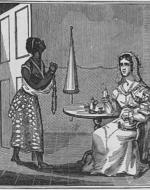Created by Emily Reeder on Mon, 03/28/2022 - 22:39
Description:
Durring the 1700s and into the 1800's there were many woman abolitionists that tried to do what they could to help the abolitionist movement in Britain. Since women durring that time had very little, if any, political power they got creative with how they planned to get their message across using writing, poetry, and illistrations to spread the word about the horrors of slavery. This image titled "The Negro Mothers Appeal" first appeared in eighteen twenty nine in an anti slavery scrapbook. The peice depicts a mother slave pleading to a white mother as their child is being taken away by a slave trader to a ship out in the distance. It is a very moving peice that helps to show the greif of slaves when their children were taken away from them and forced to be sold. It helps to show the powerlessness that people in that situation were in and creates a sense of connection and empathy between the two figures in the picture and whoever is looking at the picture. Panphlets like these were used and produced by many woman writers and artists in support of the abolitionist movements and helped to raise awareness in the general populace about the horrible treatment and impact that slavery had on people's lives. Writings such as poems and stories helped to show people the perspective of enslaved people and change the publics view against slavery. These panphlets were often given out at anti Slavery rallys and while doing public speeches. These talks about Anti-Slavery helped to inspire many authors who then wrote about womans writes and started the suffrage movement such as Mary Wollsencrafts "The Vindication of the rights of women" which used African slavery as an example of male dominance over females by saying " 'Is one half of the human species, like the poor African slaves, to be subject to prejudices that brutalise them...only to sweeten the cup of men." Which is a direct allusion to the sugar cane plantations where slaves were used to grow and harvest sugar for tea. These works of women were extremely influential to helping spread awareness amoung the general populace about the horrors of slavery and also helped to inspire the womans sufferage movements later on.


